2 - Attempts to improve urban hygiene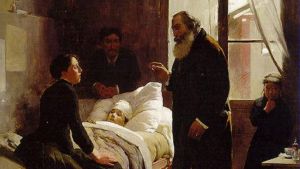 If Sanremo wanted to have a future as a health resort, therefore, it had first of all to prevent the danger of epidemics, improving hygiene and then proceeding with vaccinations.
If Sanremo wanted to have a future as a health resort, therefore, it had first of all to prevent the danger of epidemics, improving hygiene and then proceeding with vaccinations.
A further impetus for this was the numerous failures that occurred in Nice due to the absence of tourists because of the cholera epidemic. Tourists, who came from far away and travelled at great expense, wanted to find places to treat themselves, not to fall ill. It was unthinkable that wealthy tourists from the north would be willing to walk among piles of rubbish or 'foul and nauseating fumes' from cesspits or open sewage drains.
On the other hand, even if they were not particularly affected by all this, they would have demanded more urban cleanliness, and above all enough running water.
In 1871, when the foreign colony began to take on a certain consistency, thanks to the measures concerning cleanliness, although the conditions of the busiest urban streets could be considered satisfactory, there was no lack of complaints, generally in the form of letters sent to local periodicals, and almost exclusively concerning the situation of the hillside areas, secondary roads, private roads, and courtyards inside the buildings.
In the second half of the 1860s, a Sanitary Commission was set up, which was entrusted with a "Report on the hygienic state of San Remo", whose members held office for four years, and whose function was to present to the council the measures to be approved in the interest of urban hygiene.
The report of the members of the Sanitary Commission, in charge of the inspection, began as follows:
«... If it is generally rumoured that cleanliness in the upper part of the town is little cared for, those who reported it were persuaded that, on the contrary, the evil is much stronger in the lower part of the town, where, to tell the truth, judging by the streets that are daily swept, one would be inclined to believe the vulgar belief; But if, as the undersigned did, one goes into certain alleys, mountains, and hollows commonly existing behind the houses towards the gardens, one is amazed at the rubbish accumulated there; And it is astonishing how the inhabitants of the houses that watch over those filthy receptacles of filth, adapt, without complaint, to breathe the fetid fumes, and indeed with the continuous flow of every liquid and solid household waste, feed with the utmost indifference this source of miasma, so much so that it is believed that they have now lost the sense of smell ».
The report contained a detailed list of the places where urgent action was needed to avoid the danger of epidemics and to avoid leaving holidaymakers hungry, as well as a handbook of the types of action considered most appropriate.
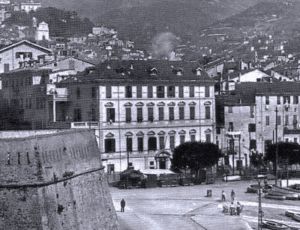 One of the many similar cases reported by the health inspectors concerned the central and monumental palazzo della Dogana, behind which,
One of the many similar cases reported by the health inspectors concerned the central and monumental palazzo della Dogana, behind which,
«... there is also a cavity with no outlet and full of garbage, but there, what is most repugnant and requires immediate shelter, is a small room on the ground floor with an open door at the side of the trattoria del Vapore, where the showers of all the toilets in the building have their outlet, to such an extent that natural excrement over a metre high can be seen in this room, and which, owing to the constant agitation produced by the matter falling from the top of the gargoyles, gives off an asphyxiating stench ».
Another case of a different nature but of equal seriousness concerned:
«...the beodo that passes through the kintagna, and the passage of that name, which are horrible things to see, especially behind the slaughterhouse in Viale Giovanni, where such a quantity of putrid water mixed with slaughterhouse blood stagnates that even the most indifferent man would be repulsed ».
In August 1871 Mayor Corradi received the results of this investigation, which he himself had requested and which give a clear picture of the conditions of Sanremo at the beginning of its touristic history and it was to change this sanitary status that also the following municipal administrations engaged in a wide range of corrective measures.
In the seventies so they intervened a lot on specific cases, reported from time to time by the sanitary inspectors, while on a general level they started to provide the city with public urinals.
In 1883, even before the aforementioned Crispi law of 1888, the city of San Remo approved the Regulation of Hygiene, updated in 1893 and substituted in 1901 by the Regulation for the hygiene of the soil and the inhabited area of the city of San Remo, in turn modified in 1909, 1911 and 1913, based on the new municipal and provincial laws and ministerials, which established the general criteria to which the various local regulations would have to adhere.
The various sanitation regulations in Sanremo, although they did not differ greatly from one another, prohibited any work that endangered the natural flow of rainwater, for which there were drainage canals along the streets; they prohibited the discharge of the contents of latrines and unclean water into streams, the sea or white canals; they imposed the paving of all urban streets with impermeable materials; They established rules for issuing the certificate of habitability for houses; they granted the mayor the power to withdraw habitability from flats considered unhealthy; they prescribed the paving of courtyards, which had to be kept free of rubbish at all times; they made latrines compulsory in the houses; they regulated the systems for collecting faecal matter and sewage; and they prohibited stables and deposits of manure and rubbish in the built-up area. Lastly, they contained provisions for drinking water pipes, wells, cisterns and wash houses.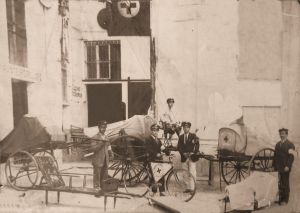 In the second half of the 1880s and in the course of the following decade, a Hygiene Office was set up, provisions were made for the slaughter of meat, a network of outlets for street washing was created, modern lavatories were built and the slaughterhouse in Valle Armea, outside the town, was finally completed.
In the second half of the 1880s and in the course of the following decade, a Hygiene Office was set up, provisions were made for the slaughter of meat, a network of outlets for street washing was created, modern lavatories were built and the slaughterhouse in Valle Armea, outside the town, was finally completed.
In January 1884, Dr Warlomont, director of the International Ophthalmic Institute based in San Remo, wrote a letter to the Mayor in which he, « animated by the desire to contribute to the well-being and growth of this city, communicates to the Council a fragment or chapter of a book, soon to be published in Paris and Brussels under the title "Ou faut-il passer ses hivers? (Where should one spend one's winters?), which fragment deals with the healthiness of dwellings in relation to the transmissibility and infectiousness of tuberculosis, and contains various proposals to provide for this healthiness in an appropriate manner ».
In the meantime, however, the various Administrations, both municipal and provincial, often recommended keeping a close watch on the dangers of contagions, especially cholera and smallpox, which were still circulating in various parts of the country.
In November 1884 it was reported that cholera had disappeared from all parts of the Kingdom, except for a few cases.
However, in the session of 28 June 1884 the Council decided as a matter of urgency, "in view of the danger of a cholera invasion", to authorise the Mayor to issue all the necessary measures and carry out all the necessary works in the interest and for the protection of public health.
In 1885, however, cholera broke out in Marseille and a strict medical examination of people entering the Kingdom and their luggage was immediately carried out on all the main communication routes on the borders between Italy and France.
The Minister of the Interior orders that
« - Every railway train travelling from Ventimiglia to Savona shall have a special carriage with a latrine for the accommodation and treatment of travellers suffering from a suspected illness during the journey;
- this wagon shall be escorted by sufficient medical staff and supplied with medicines, disinfectants and everything necessary to treat the sick;
- the sick persons admitted in the hospital wagon will be deposited at the nearest station, which will have suitable rooms for receiving them in isolation;
- when it is necessary to deposit a traveller suffering from a suspected illness in a Municipality, the Municipal Authority must be informed in advance by the Station Master, in order to agree with them the precautions to be taken when transporting the sick to the premises set aside for treatment ».
In 1885, the Prefect made a number of recommendations to the mayors: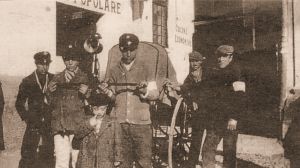 « The summer season is approaching, the season that is most favourable for the development of epidemic diseases. And since there are no signs of the return of the disease that unfortunately infested the town last year, we cannot deny the need to adopt preventive measures to prevent the generation and spread of any infectious disease, and especially to remove any source of infection by keeping the streets, squares, schools and other public places as clean as possible, as well as inside and around private homes.
« The summer season is approaching, the season that is most favourable for the development of epidemic diseases. And since there are no signs of the return of the disease that unfortunately infested the town last year, we cannot deny the need to adopt preventive measures to prevent the generation and spread of any infectious disease, and especially to remove any source of infection by keeping the streets, squares, schools and other public places as clean as possible, as well as inside and around private homes.
It is also agreed that, in addition to the vigilance attributed by law to the municipal authority, which must be very strict, regarding the quality of foodstuffs and drinks offered for sale, and the wholesomeness of drinking water, the municipal representatives should endeavour to make their fellow citizens understand that, in order to be in good health and thus be able to resist the onslaught of disease, it is also necessary to take care of the cleanliness of the person, adopt a healthy diet, avoid disorders of all kinds and during the summer be moderate in the use of fruit.
Moreover, it is not enough to meet the needs of the present, we must also take care of the future, i.e., to ensure that the observance of the above-mentioned rules of hygiene enters into the habits of the people so that the new generations grow up healthy and robust and can thus improve their conditions both moral and material, since it is proven that the development of intelligence usually goes hand in hand with the development and invigoration of the body.
The painful fact that in this Province, although so favoured by nature, there are many young men who are declared unfit for military service due to a lack of physical development leads me to call the attention of the municipal administrations to this ».
But in 1886 the epidemic spread throughout the Kingdom and the Prefect informed the Mayor that « the Municipality of Rome, to which the King's August Majesty, moved by the announcement of the grave misfortunes that the cholera epidemic was spreading among its people, gave the most noble mandate to collect abundant donations from the whole nation to help so much misery and alleviate such acute pain, is addressing through me the moral bodies of this province to help the poor, commissioned the most noble mandate to collect from the charity of the whole nation copious offerings to help so many miseries and soothe such acute pains, addresses through me the moral bodies of this province in order to obtain their generous help.
In informing Your Excellency of this, I beg you to share it with the Municipal Council, inviting it to vote, within the limits of the municipal finances, for aid for those affected by the scourge.
I would also ask you to address a similar invitation to the moral organisations existing in this Municipality which have as their objective charity, savings, mutual aid and welfare, and to stimulate all the patriotic societies and mutual aid, professional and recreational associations etc. to take up this noble enterprise, so that they may allocate funds to increase their funds, To stimulate all patriotic societies and mutual aid, professional, or recreational associations etc., to increase the funds of charity by means of some of their collective or personal offerings, and to encourage everyone, wherever possible, to open subscriptions in newspapers and to promote expedients, such as public lotteries, raffles, regattas, theatrical performances, musical performances, concerts, paid recreational evenings, the placing of alms urns in public places to collect charitable donations, etc. ».
After affecting more than 50,000 people, with over 2,000 deaths, the disease subsided the following year.
In anticipation of the 1887 summer season, the Prefect wrote:
« The sanitary conditions of the Kingdom are satisfactory, and everything leads us to believe that the present state of safety can continue in the long term.
But such a hope should not prevent the authorities responsible for the protection of public health from attempting all means to avert even the remotest possibility of danger before the summer season arrives, both in the municipalities that in the past year were more or less infested with cholera, and in all the others ».
1887 was also the year of the earthquake that devastated entire municipalities in the Province and on 20 July the Prefect reiterated:
« Now that the heat is in full swing, and is all too favourable to the manifestation of epidemic diseases, it is more necessary than ever that mayors do their utmost to take care of public hygiene, especially in those municipalities whose population lives in huts.
The experience of recent years, during which epidemics have followed one another, now in one part of the Kingdom and now in another, has clearly shown that cleanliness is one of the most effective preservers of diseases, especially those of a diffusive nature.
I therefore deem it opportune, although the sanitary conditions of our Province are satisfactory, to strongly recommend the cleaning of the streets and public squares, especially where rubble is still piled up, and to order their immediate removal, or at least their disinfection with chloride of lime dissolved in water, as well as public and private toilets, and especially those of hotels and public establishments, through which contagious diseases could easily be spread by travellers. They shall also order the immediate removal of dung and manure deposits of any kind that are found in the built-up area or near public squares and streets.
In those municipalities where the population, or part of it, lives in huts, the implementation of the above-mentioned suggestions is even more recommended, practising frequent cleaning and disinfection of the huts, and avoiding agglomerations of people in enclosed places, so that breathing does not become difficult and pernicious ».
This was followed by a period of relative tranquillity until, in 1892, Minister Giolitti wrote:
« The threatening spread of the cholera epidemic in countries bordering ours or with ours in continuous and important commercial relations, makes it imperative for all provincial and municipal health authorities to assist, with their most scrupulous vigilance, the work of the Government, in order to prevent the feared infection from making its way into the country and, in the unfortunate event that this should happen, to ensure that it does not find it easy to take root and spread among our populations, and that any possible first outbreaks of the disease are immediately suffocated ».
Detailed instructions to prevent the development and spread of cholera were attached to the circular.
The following year, the number of cholera cases in the south of France increased and border health controls were intensified. This did not prevent 10 cases from occurring in the Province of Porto Maurizio.
In the meantime, at the council meeting of 22 October 1889, the mayor reported on the city's cleaning service, saying that « it is provided "with women on a daily basis", by the council and by the urban police ».
It is true that there is the inconvenience of piles of rubbish being deposited along the streets late in the evening by those families who have no way of exporting it, but there are difficulties in providing a more suitable service. 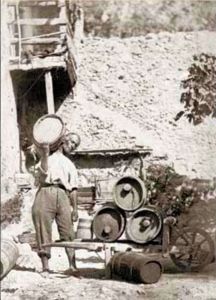 Moreover, the rubbish is collected in special places, from which it is removed by a carter who, for some time, paid the Municipality £1 per day.
Moreover, the rubbish is collected in special places, from which it is removed by a carter who, for some time, paid the Municipality £1 per day. 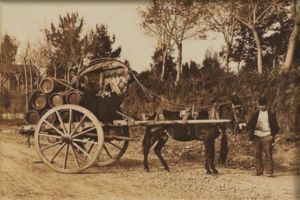 It would now be necessary to find a way of providing for this; perhaps a cart with a bell, as is used in other major cities, would be appropriate.
It would now be necessary to find a way of providing for this; perhaps a cart with a bell, as is used in other major cities, would be appropriate.
Councillor engineer Ernesto Marsaglia « suggests the use of deposits in suitable rooms inside the houses. Or, according to him, the sweepers could be obliged to collect the rubbish directly from the families, without obliging them to pay any fee.
Stating that the latter method was used in the City of Genoa, councillor Vincenzo Manuel Gismondi recommended it to the Council, which "willingly accepted the Mayor's recommendation ».
In 1890, the Municipal Council decided to build a section of masonry sewer in the S. Romolo stream between the Market Square and the railway bridge, and to lay a cast-iron pipe from the bridge to the sea, where the pipe will be buried for 20 metres.
In the same year, it was decided to build a disinfecting oven using the superheated steam method, with which "it is possible to disinfect 50 complete beds in one day".
The plant was to be built "in the area of land to the west of the fort near the sea".
At the council meeting of 26 October 1891, councillor Vincenzo Manuel-Gismondi, in dealing with budgetary expenditure, proposed « a suitable increase to improve the daily pay of the public sweepers. He notes that they are often forced to resort to public charity; that they carry out painful work that is not free from illness ».
The President, Mayor Alessandro Escoffier, considers the proposal to be fair, as the sweepers' pay is very small. « except that it should be noted that this serves as an excuse for them to resort to the Charity Committee. It should also be noted that their daily work is limited to the early morning and evening hours, so that they have the opportunity to earn some money from other services that they can perform on their own. It should also be borne in mind that the municipal administration, preferably and if necessary, employs the sweepers in other jobs paid for separately ». He concluded by stating that even if they were paid more, the service would not be any better or more.
While leaving the proposed allocation as it is, councillor Augusto Mombello believes that the Council should study and resolve the matter, « as it is not honourable for the Municipality to be told how it keeps poorly paid people in its service. He then recommends that the council itself purchase a machine for sweeping the streets ».
At the council meeting of 27 August 1900, the councillor Paolo Eugenio Carbonetto "briefly outlines the proposal, made some time ago, « for the purchase of a mechanical sweeper drawn by horses, and mentions the advantages of the system adopted elsewhere, with savings in the cost of cleaning the streets and other public spaces ».
In this regard, the Councillor, Engineer Antonio Tornatore, reports that the Council has for some time now been carrying out the appropriate studies for the choice of a suitable sweeper system, and has made the necessary arrangements for the purchase of the machine and its price.
He then announces that he has opened negotiations with the industrial company Gola & Canelli of Milan, who would be obliged to supply a Barrows sweeper to a horse, at the price of £1,150.
He describes the form and operation of the machine, demonstrates the advantages to be gained, and proposes that it be purchased. Acknowledging the convenience of the proposal, the Council, without discussion and by full agreement, approves it.
In 1894, the Bureau of Hygiene was provided with the necessary equipment to carry out the chemical examination of foodstuffs.
The following year a « better system of public wash-houses was provided, with a view to avoiding the washing of clothes which, at present, is done in communion, with the possible damage of communicating certain serious diseases ».
In the budget for 1898, the allocation of £1,423 for the maintenance of lepers in San Remo was increased.
In 1900, the Council of 24 August approved the insertion of the following new article in the Hygiene Regulations: « Within the perimeter of the city, which extends from the sea to the height of the Sanctuary of the Assumption, and from the Val d'olivi stream to the Bernardo stream, it is forbidden to beat carpets and other objects used in inns, villas and houses in order to remove them, except in those places that will be designated from time to time by the Mayor, after hearing the opinion, in writing, of the Health Officer ».
At the beginning of the new century, conditions in the city could justifiably be considered much improved. The measures adopted by the council, the administrative sanctions passed by the council, the actions of the urban police force, as well as an evolution in the hygienic habits of the people of Sanremo had made garbage disappear even from courtyards and side streets.
The Sanremo of the Belle Époque was now an avant-garde tourist resort, where the "sweeping" of the streets was largely mechanised and where the "watering" of the streets was punctual and efficient, thanks to the quantity of drinking water now available thanks to the new Marsaglia Aqueduct. This side of the hygiene issue had therefore been partially resolved.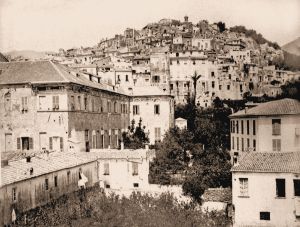 We say partially because the healthy part of the city was only that formed by the suburban residential districts and the business centre on the plain, while in the "old" city the hygienic conditions had remained the same as they were two decades earlier, with its unhealthy buildings and smelly alleys. This was the real issue: the problems were not taken into consideration by the successive administrations, according to their absolute seriousness, but only because they could damage the development of tourism.
We say partially because the healthy part of the city was only that formed by the suburban residential districts and the business centre on the plain, while in the "old" city the hygienic conditions had remained the same as they were two decades earlier, with its unhealthy buildings and smelly alleys. This was the real issue: the problems were not taken into consideration by the successive administrations, according to their absolute seriousness, but only because they could damage the development of tourism.
With regard to the question of hygiene, the organisation of the health system to prevent infectious diseases was always topical. From the middle of the century onwards, emergency measures were put in place, which were to come into force whenever there was an alarm, a sanitary inspector was elected to control foodstuffs, a necropsy service was organised, the sanitary system was reorganised and a night sanitary service was set up.
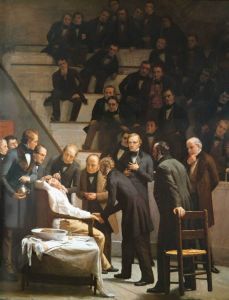 By the time the results of Koch's discovery had become widespread, and especially after the publication of a statistic by the sanitary inspector in San Remo - according to which the percentage of deaths from tuberculosis out of the total number of deaths in the municipality had risen from an insubstantial percentage in 1870 to 9.5% in 1875, 12.4% in 1884, 18.0% in 1889 and 30.0% in 1890 - the problem of contagion was tackled with a very different determination and fear.
By the time the results of Koch's discovery had become widespread, and especially after the publication of a statistic by the sanitary inspector in San Remo - according to which the percentage of deaths from tuberculosis out of the total number of deaths in the municipality had risen from an insubstantial percentage in 1870 to 9.5% in 1875, 12.4% in 1884, 18.0% in 1889 and 30.0% in 1890 - the problem of contagion was tackled with a very different determination and fear.
Until then it was cholera that was most feared in Sanremo, but from that decade onwards, due to the fact that the city was home to a large number of tisicians, now suddenly discovered to be contagious, it was tuberculosis that was to become a sort of collective nightmare.
Medical statistics showed that the disease was spreading among the local population and Sanremo risked being seen abroad no longer as a climatological treatment centre, but as a large sanatorium for tisicians.
This could have led to the exclusion of the Ligurian town from the great tourist circuit and consequently to the collapse of the local economy. The drastic drop in the number of holidaymakers in the 1990s was a sign of this.
The municipal administration was called upon to act, and act fast. And so, in the same decade, a service for the treatment of contagious infectious diseases was set up, to the benefit of the resident population; a project for a steam oven for disinfection was studied and implemented, followed by the organisation of a home disinfection service.
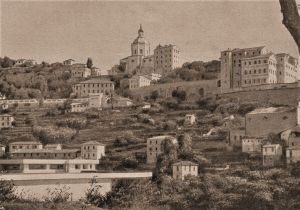 Lastly, the Mauriziano, already used as a lazaret, was transformed into a real hospital, and was also equipped with a special apparatus for disinfection, as well as a whole series of modern equipment of the time. In order to facilitate the constant presence of medical staff, a building was built in 1895 to house them, which was later called "The Doctors' House".
Lastly, the Mauriziano, already used as a lazaret, was transformed into a real hospital, and was also equipped with a special apparatus for disinfection, as well as a whole series of modern equipment of the time. In order to facilitate the constant presence of medical staff, a building was built in 1895 to house them, which was later called "The Doctors' House".
« ...which takes in the contagious hotels and pensions as well as the others who are without any proper attention. They get the best attendance possible under the superintendence of two appointed physicians. is provided with a grand apparatus for disinfection and in all cases, when a room has been infected, this as well as the supplies undergo an energetic disinfection". (original text) ».
The purpose of the disinfection service, which was the most important and effective measure taken by the administration, was to sterilise the rooms in the hotels and villas where tuberculosis patients had stayed and also to disinfect objects that might have been contaminated by the bacteria, while burning anything that, like foodstuffs, could not be sterilised. The service was compulsory and it was up to the hoteliers and tenants to request and pay for it. Failure to do so could result in heavy fines and the withdrawal of the licence.
The hysteria that afflicted many in those years meant that new precautionary measures, the most abstruse of which were constantly being invoked in the newspaper columns. There were those who, when it was still believed that it was the spit of people with consumption disorders that spread the germs, asked that all public places be provided with hermetically sealed spittoons to be disinfected daily; there were those who called for the creation of places and walks reserved for people with tuberculosis; and finally there were those who insisted that the regulations of the city police should include a ban on people with consumption disorders spitting on the ground.
In such a climate, the favourable decision taken by the municipal council - with a socialist majority - in 1903 regarding the proposal to establish a large sanatorium for the treatment of tuberculosis was strongly opposed.
Tourism had already begun to change in a modern direction. Towards the end of the century, the tourists who came for unavoidable health reasons were reduced to a minority and when the question of the sanatorium first arose, it was the members of the English, French and German colonies who protested, threatening never to return to Sanremo if the city was transformed into an infection foyer.
In the new century, the administration continued its fight against infectious diseases. To this end, rooms were built for the isolation of suspected infected persons, the entire health service was reorganised to favour the treatment of the infected, and a cabinet for clinical analyses was founded.
Before the Great War, there were still many projects to be implemented to combat contagious diseases.
In 1913 we read in the Report of the Municipal Council of San Remo:
« The isolation rooms for infectious diseases are no longer fit for purpose.... This need for new adequate premises for infectious diseases was felt especially in the English Colony, which proposed to build a small isolation hospital at its own expense... But as the English Hospital is only capable of a few beds, and will have to be reserved preferably for the English Colony, it is necessary that the city hospital be built next to it...
The project for the new hospital was studied by the Hygiene Office and is ready in all its details, including the disinfection station....».
However, the war interrupted the realisation of the projects under study and in the immediate post-war period, the city's resources, which had become very meagre due to the paralysis of the tourist movement, were directed towards essential work.




